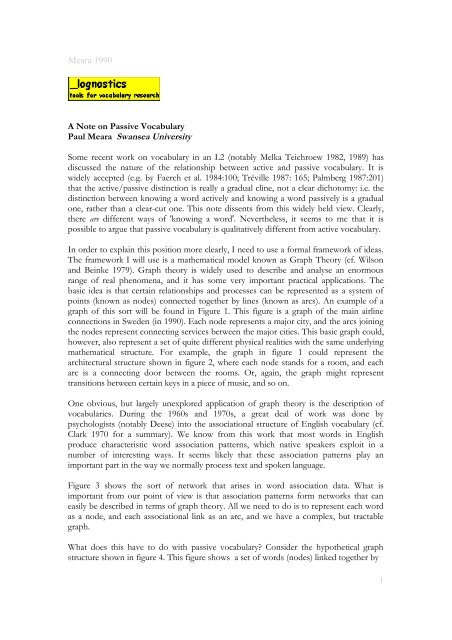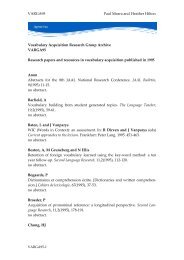A Note on Passive Vocabulary - Lognostics
A Note on Passive Vocabulary - Lognostics
A Note on Passive Vocabulary - Lognostics
Create successful ePaper yourself
Turn your PDF publications into a flip-book with our unique Google optimized e-Paper software.
Meara 1990<br />
A <str<strong>on</strong>g>Note</str<strong>on</strong>g> <strong>on</strong> <strong>Passive</strong> <strong>Vocabulary</strong><br />
Paul Meara Swansea University<br />
Some recent work <strong>on</strong> vocabulary in an L2 (notably Melka Teichroew 1982, 1989) has<br />
discussed the nature of the relati<strong>on</strong>ship between active and passive vocabulary. It is<br />
widely accepted (e.g. by Faerch et al. 1984:100; Tréville 1987: 165; Palmberg 1987:201)<br />
that the active/passive distincti<strong>on</strong> is really a gradual cline, not a clear dichotomy: i.e. the<br />
distincti<strong>on</strong> between knowing a word actively and knowing a word passively is a gradual<br />
<strong>on</strong>e, rather than a clear-cut <strong>on</strong>e. This note dissents from this widely held view. Clearly,<br />
there are different ways of 'knowing a word'. Nevertheless, it seems to me that it is<br />
possible to argue that passive vocabulary is qualitatively different from active vocabulary.<br />
In order to explain this positi<strong>on</strong> more clearly, I need to use a formal framework of ideas.<br />
The framework I will use is a mathematical model known as Graph Theory (cf. Wils<strong>on</strong><br />
and Beinke 1979). Graph theory is widely used to describe and analyse an enormous<br />
range of real phenomena, and it has some very important practical applicati<strong>on</strong>s. The<br />
basic idea is that certain relati<strong>on</strong>ships and processes can be represented as a system of<br />
points (known as nodes) c<strong>on</strong>nected together by lines (known as arcs). An example of a<br />
graph of this sort will be found in Figure 1. This figure is a graph of the main airline<br />
c<strong>on</strong>necti<strong>on</strong>s in Sweden (in 1990). Each node represents a major city, and the arcs joining<br />
the nodes represent c<strong>on</strong>necting services between the major cities. This basic graph could,<br />
however, also represent a set of quite different physical realities with the same underlying<br />
mathematical structure. For example, the graph in figure 1 could represent the<br />
architectural structure shown in figure 2, where each node stands for a room, and each<br />
arc is a c<strong>on</strong>necting door between the rooms. Or, again, the graph might represent<br />
transiti<strong>on</strong>s between certain keys in a piece of music, and so <strong>on</strong>.<br />
One obvious, but largely unexplored applicati<strong>on</strong> of graph theory is the descripti<strong>on</strong> of<br />
vocabularies. During the 1960s and 1970s, a great deal of work was d<strong>on</strong>e by<br />
psychologists (notably Deese) into the associati<strong>on</strong>al structure of English vocabulary (cf.<br />
Clark 1970 for a summary). We know from this work that most words in English<br />
produce characteristic word associati<strong>on</strong> patterns, which native speakers exploit in a<br />
number of interesting ways. It seems likely that these associati<strong>on</strong> patterns play an<br />
important part in the way we normally process text and spoken language.<br />
Figure 3 shows the sort of network that arises in word associati<strong>on</strong> data. What is<br />
important from our point of view is that associati<strong>on</strong> patterns form networks that can<br />
easily be described in terms of graph theory. All we need to do is to represent each word<br />
as a node, and each associati<strong>on</strong>al link as an arc, and we have a complex, but tractable<br />
graph.<br />
What does this have to do with passive vocabulary? C<strong>on</strong>sider the hypothetical graph<br />
structure shown in figure 4. This figure shows a set of words (nodes) linked together by<br />
1
Meara 1990<br />
Figure 1:<br />
Direct intercity air routes in Sweden (in 1990)<br />
Su<br />
Go<br />
N<br />
Figure 2:<br />
An architectural design with the same graph structure as Figure 1.<br />
associati<strong>on</strong>s (arcs). The associati<strong>on</strong>s are directi<strong>on</strong>al; even though all the words are<br />
c<strong>on</strong>nected to the network as a whole, you can <strong>on</strong>ly move from <strong>on</strong>e word to another in<br />
the directi<strong>on</strong>s indicated by the arrows. In real life, this corresp<strong>on</strong>ds to the fact that<br />
associati<strong>on</strong>s are not generally symmetrical: for instance CABBAGE will often elicit white<br />
or green as associati<strong>on</strong>s, but not vice versa.<br />
The interesting case for us is node H in Figure 4. This node is clearly part of the overall<br />
network structure, but its place in the network is very different from that of all the other<br />
nodes. The other nodes are c<strong>on</strong>nected to the network by two kinds of arcs: each node<br />
has arcs which lead to it, and other arcs which lead away from it. Node H <strong>on</strong>ly has nodes<br />
Jo<br />
St<br />
Ma K<br />
Su Go<br />
Jo St Ma<br />
N K<br />
2
Meara 1990<br />
Figure 3: A simple word associati<strong>on</strong> network<br />
ROSE FLAG<br />
FLOWER RED<br />
DAFFODIL SKY SEA<br />
YELLOW BLUE<br />
DAISY WHITE CLOUD<br />
SNOW RAIN<br />
which lead away from it. This means that if you start off at node H it is possible for you<br />
to reach all the other nodes in the system. On the other hand, if you start from anywhere<br />
else in the system, then node H is completely inaccessible.<br />
Node H corresp<strong>on</strong>ds to my idea of a passive vocabulary item. Active vocabulary is<br />
vocabulary which is easily accessed from anywhere in the vocabulary network, and in its<br />
turn allows easy access to other parts of the system too. <strong>Passive</strong> vocabulary, <strong>on</strong> the other<br />
hand, comprises vocabulary items that are part of the overall system, but which cannot be<br />
reached from other parts of the network. In effect, they can <strong>on</strong>ly be accessed if an<br />
appropriate external stimulati<strong>on</strong> is available. You can recognise passive vocabulary when<br />
you see it, or when you hear it, but you are unable to bring it to mind without this<br />
external support.<br />
This descripti<strong>on</strong> suggests that the distincti<strong>on</strong> between active and passive vocabulary is a<br />
clear <strong>on</strong>e, not a gradual <strong>on</strong>e. <strong>Passive</strong> vocabulary c<strong>on</strong>sists of items which resp<strong>on</strong>d <strong>on</strong>ly to<br />
external stimuli; active vocabulary does not require an external stimulus, but can be<br />
activated by other words. Of course, active vocabulary may come in many shades of<br />
activity level - some words may be absolutely key words, central to the entire network of<br />
associati<strong>on</strong>s; others may be more peripheral, activated <strong>on</strong>ly in the c<strong>on</strong>text of other closely<br />
related words. Active vocabulary clearly exists <strong>on</strong> a c<strong>on</strong>tinuum of some sort; passive<br />
vocabulary, according to the view put forward here, is qualitatively different.<br />
Readers who have grasped the basic idea of graphs, and the way they can be used to<br />
describe relati<strong>on</strong>s between words, may now be w<strong>on</strong>dering what happens if you have a<br />
node where all the arcs point inwards, but no arcs emerge from it. Such a point is<br />
technically known as a sink. Interestingly, this sort of thing does seem to occur in a real-<br />
3
Meara 1990<br />
Figure 4:<br />
a hypothetical associati<strong>on</strong> network<br />
A<br />
L B<br />
K C<br />
J D<br />
I E<br />
H G<br />
life c<strong>on</strong>diti<strong>on</strong> known as Gille de la Tourette's syndrome (cf. van Lancker 1987). Patients<br />
suffering from this c<strong>on</strong>diti<strong>on</strong> have a limited expressive vocabulary, largely c<strong>on</strong>sisting of<br />
obscene words and curses. It would be interesting to know whether there are any<br />
recorded instances of L2 speakers with this syndrome, and whether it affects both the L1<br />
and the L2 in the same way.<br />
Finally, it might be worth adding a few words about how passive vocabulary becomes<br />
active. Traditi<strong>on</strong>al methods of teaching vocabulary rely very much <strong>on</strong> teaching single<br />
words, and providing active practice for words that are not well known. The sort of<br />
model I have outlined here suggests that this methodology might not be an efficient way<br />
of c<strong>on</strong>verting passive vocabulary into active vocabulary. <strong>Passive</strong> vocabulary may already<br />
have good links with the active parts of the network; merely supplying the word and<br />
asking for it to be used appropriately reinforces these already existing links, but does<br />
nothing to create the new inward-pointing links that an active word requires. This<br />
suggests that exercises which deliberately stress the associati<strong>on</strong> links leading from already<br />
known words to newly learned words might be a more effective way of activating a<br />
passive vocabulary.<br />
F<br />
4
Meara 1990<br />
REFERENCES<br />
Clark, H. 1970.<br />
Word associati<strong>on</strong>s and linguistic theory. In: J Ly<strong>on</strong>s (ed.) New Horiz<strong>on</strong>s in Linguistics.<br />
Harm<strong>on</strong>dsworth: Pelican.<br />
Faerch, C., K. Haastrup and R Phillips<strong>on</strong>. 1984.<br />
Learner Language and Language Learning. Cleved<strong>on</strong>: Multilingual Matters.<br />
Melka Teichroew, FJ. 1982.<br />
Receptive vs. productive vocabulary: a survey. Interlanguage Studies Bulletin 6,2(1982), 5-33.<br />
Melka Teichroew, FJ. 1989.<br />
Les noti<strong>on</strong>s de recepti<strong>on</strong> et de producti<strong>on</strong> dans le domaine lexical et semantique. Bern: Peter Lang.<br />
Palmberg, R. 1987.<br />
Patterns of vocabulary development in foreign language learners. Studies in Sec<strong>on</strong>d<br />
Language Acquisiti<strong>on</strong> 9(1987), 201-220.<br />
Tréville, M.C. 1988.<br />
Faut-il enseigner le vocabulaire dans la langue sec<strong>on</strong>de? In : R. LeBlanc, R. Compain,<br />
L. Duquette and H Séguin (eds.) L'enseignement des langues sec<strong>on</strong>ds aux adultes: recherches et<br />
practiques. Ottawa: Presses de l'Université d'Ottawa.<br />
van Lanker, D. 1987.<br />
N<strong>on</strong>propositi<strong>on</strong>al speech: neurolinguistic studies. In: A. Ellis (ed.) Progress in the Psychology<br />
of Language. vol. III. Hillsdale, N.J.: Lawrence Erlbaum Associates.<br />
Wils<strong>on</strong>, R. and L. Beineke. 1979.<br />
Applicati<strong>on</strong>s of graph theory. New York: Academic Press.<br />
This paper first appeared in: Sec<strong>on</strong>d Language Research 6,2(1990), 150-154.<br />
5



